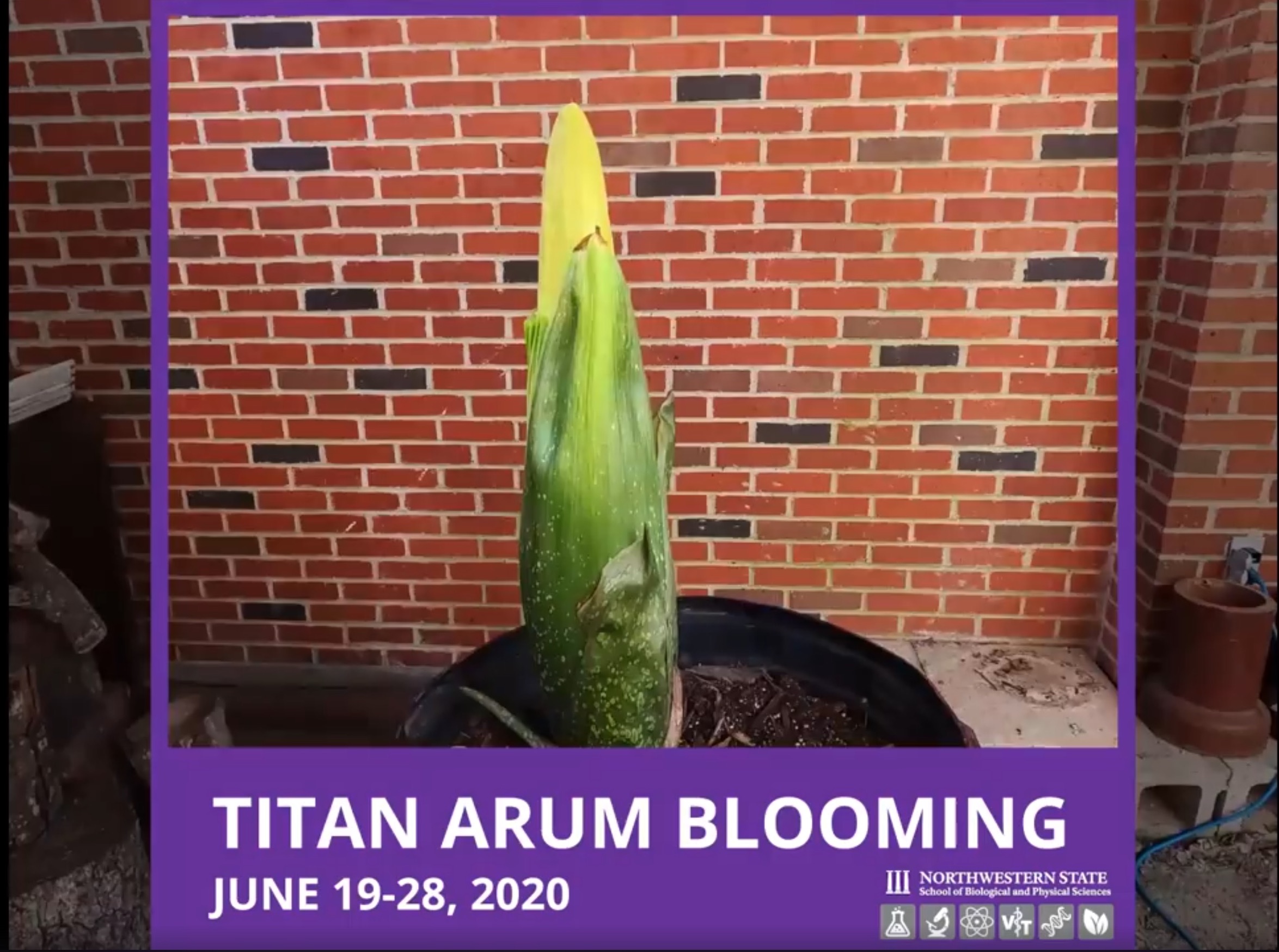NATCHITOCHES – The buzz surrounding Mr. Stinky is still going strong. Following the magnificent bloom of Northwestern State University’s resident corpse flower, botanists, plant enthusiasts and the curious were still contacting biology faculty about the plant. Dr. Michael Scanlan’s timelapse video of Stinky’s flowering, which began June 19 and matured about 1:30 a.m. Saturday, June 26 was viewed and shared by thousands. By Tuesday, the giant purple bloom was gone.
The timelapse video can be viewed on the School of Biological and Physical Sciences’ youtube channel at https://www.youtube.com/watch?v=qAuC2hJSJHc and the School’s Facebook page at https://www.facebook.com/NSULASciences/videos/909765379536096/UzpfSTE0MTA0MzIyNDE6MTAyMjQ0Njg4NTExMzQ3MjY/.
Professor Millard Mangrum has continued to field requests for interviews and information about the plant, whose scientific name is amorphophallus titanium or titan arum. The rare giant tropical plant is native to Sumatra, Indonesia, and only flowers every eight or 10 years. As it blooms, titan arum gives off a powerful foul odor politely described by Mangrum as “decaying proteins,” hence the common name corpse plant. Mr. Stinky lived up to the species’ reputation during its full bloom early Saturday morning.
Mangrum estimated that more than 500 people viewed the plant Friday but couldn’t be sure of the number that came Saturday because so many returned throughout the day, often bringing friends.
Mangrum acquired the plant’s corm, similar to a bulb, in 2012. After years of being carefully nurtured by him and colleagues Corbin Covher and John Byrd, the plant affectionately known as Mr. Stinky grew to an astonishing 10-foot height with a large leafy canopy. This year, after dying back to the corm, Stinky developed a spike that indicated a bloom was imminent.
Mr. Stinky’s caregivers watched carefully as the spike grew 6-10 inches every day and expected the bloom late last week. Friday afternoon, it began unfurling its large single purple petal as a crowd gathered to witness the rare spectacle.
Mr. Stinky’s media exposure extended to the botany faculty at California State University-Stanislaus, where they are awaiting the imminent bloom of their own corpse plant. One professor emailed Mangrum to inquire about collecting pollen from Mr. Stinky’s bloom.
“Our arum is going to open in a day or two and we were hoping to pollinate it with non-self pollen,” wrote Dr. Stuart Wooley, professor or botany at Stan State. “We’d be willing to send you some seeds, if we can get some successful seed set. Your lily was the only one we could find that was even close to the right stage.”
On Tuesday, June 30, as Stinky was collapsing, Mangrum and Byrd attempted to collect some of the genetic material, without success.
“It’s too late and we can’t isolate any of the pollen,” Mangrum said.
As the flower dies down, a sprout will be exposed that may or may not grow immediately into a foliage stem, Mangrum explained. There is also a secondary sprout that appeared prior to Stinky’s bloom that faculty speculate might be grow into another bloom.
“The other sprout may form a flower. We have been offered pollen from Southern Cal if it is a flower. There may be some seeds, but you need pollen from another flower to do the job. If all goes according to plan the vegetative state will soon appear to replenish the corm with energy for it to continue. Thus the life of Arum,” Mangrum said.

